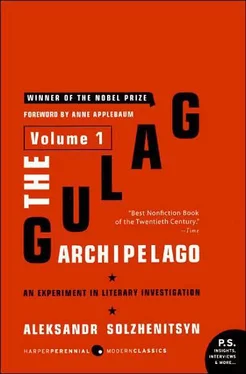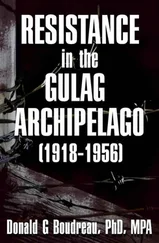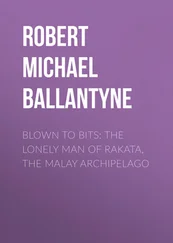This kind of unity compelled attention. It wasn’t the sort of thing you could allow to go in one ear and out the other. One day before the time limit expired, Eichmans visited each monastery and announced that Moscow had refused. And on the appointed day a hunger strike began (not a dry hunger strike—water was allowed) in all three monastery prisons (which were now unable to communicate with each other). In Sawatyevsky, about two hundred people struck. Those who fell ill were exempted from striking. A doctor from among the prisoners examined the strikers every day. A collective hunger strike is always more difficult to carry out than an individual one; after all, the weakest rather than the strongest of the strikers can determine its outcome. The only point to a hunger strike is to carry it out with implacable determination and in such a way that everyone knows everyone else involved personally and trusts them fully. Given various party fractions, given several hundred people, both disagreements and moral anguish on other people’s behalf were inevitable. After fifteen days, it was necessary to vote by secret ballot in Sawatyevsky—the urn with the ballots was taken from room to room—whether to continue or to lift the hunger strike.
And Moscow and Eichmans waited them out! After all, they were well fed, and there wasn’t a peep from the capital newspapers about the hunger strike, and there were no student protest meetings at Kazan Cathedral. Silence was already confidently shaping our history.
The monasteries lifted the hunger strike. They had not won out, but they hadn’t lost either. The political regimen was left intact for the winter, except that cutting firewood in the forests was added, but that was logical enough. And in the spring of 1925 it looked as though the hunger strike had brought victory: the prisoners from all three monastery prisons were removed from Solovki! To the mainland! No more Arctic night and no more half-year cut off from communication!
But both the convoy and their rations en route were very harsh for that time. And soon they were all perfidiously tricked: On the pretext that their spokesmen would be more comfortable in the “staff” car with the stores and equipment, they were deprived of their leaders. The “staff” car was detached at Vyatka, and the spokesmen were taken to the Tobolsk isolator. Only at that point did it become clear that the hunger strike of the previous fall had failed. The strong and influential spokesmen had been taken away so as to tighten up on the rest. Yagoda and Katanyan personally directed the incarceration of the former Solovetsky Islands prisoners in the long-standing but until then unused buildings of the Verkhne-Uralsk Isolator, which they thus “opened” in the spring of 1925 (under Chief Dupper). It was destined to be a particular bugbear to prisoners for many decades ahead.
The relocated former Solovki prisoners immediately lost their freedom to move about. The cells were locked. They succeeded in electing spokesmen nonetheless, but the spokesmen didn’t have the right to go from cell to cell. The unlimited circulation between cells of money, personal articles, and books, which had existed earlier, was now forbidden. They shouted back and forth from window to window—until the guard fired from his tower into the cells. In reply they organized a protest—they broke windowpanes and destroyed prison equipment. (And, after all, breaking a windowpane is something to think about twice. They might just not replace it all winter, and there would be no big surprise in that. It was under the Tsar that the glaziers used to come on the run.) The struggle continued, but it was now being carried on in desperation and under grave handicaps.
In the year 1928 (according to Pyotr Petrovich Rubin) some event or other precipitated a new joint hunger strike by the entire Verkhne-Uralsk Isolator. But this time the earlier stern and solemn atmosphere was absent, as were the approval of friends and a doctor of their own. On a certain day of the strike, the jailers came bursting into the cells in overwhelming numbers, and simply began to beat the weakened prisoners with clubs and boots. They beat them to within an inch of their lives—and the hunger strike ended.
From our experience of the past and our literature of the past we have derived a naive faith in the power of a hunger strike. But the hunger strike is a purely moral weapon. It presupposes that the jailer has not entirely lost his conscience. Or that the jailer is afraid of public opinion. Only in such circumstances can it be effective.
The Tsarist jailers were still inexperienced. They got nervous if one of their prisoners went on a hunger strike; they exclaimed over it; they looked after him; they put him in the hospital. There are many examples, but this work is not about them. It is even humorous to note that it was enough for Valentinov to go on a hunger strike for twelve days: as a result, he not only achieved some relaxation in the regimen but was totally released from interrogation—whereupon he went to Lenin in Switzerland. Even in the Orel central hard-labor prison the strikers always won. They got the regimen relaxed in 1912 and further relaxed in 1913, to the point of general access to outdoor walks for all political hard-labor prisoners—who were obviously so unrestricted by their supervisors that they managed to compose and send out to freedom their appeal “to the Russian people.” (And this from the hard-labor prisoners of a central prison!) Furthermore, it was published. (It’s enough to make one’s eyes pop out of one’s head! Someone has to have been crazy!) It was published in 1914 in issue No. 1 of the Vestnik Katorgi i Ssylki—the Hard-Labor and Exile Herald. [277](And what about that Herald itself?
Should we, too, perhaps try to publish one like it?) In 1914, after only five days of a hunger strike—admittedly, without water—Dzerzhinsky and four of his comrades obtained all their numerous demands (which had to do with living conditions). 12
In those years, there were no dangers or difficulties for the prisoner beyond the torments of hunger. They could not beat him up for going on a hunger strike, nor sentence him to a second term, nor increase his term, nor shoot him, nor send him off on a prisoner transport. (All this was to come later on.)
In the Revolution of 1905 and the years following it, the prisoners felt themselves to be masters of the prison to such an extent that they did not even go to the trouble of declaring a hunger strike; they simply destroyed prison property (so-called “obstructions”), or went so far as to declare a strike, although it might seem that for prisoners this would have hardly any meaning. Thus in the city of Nikolayev in 1906, 197 prisoners in the local prison declared a “strike” in conjunction with people outside. Outside the prison, leaflets in support of their strike were published and daily meetings assembled in front of the prison. These meetings (and it goes without saying that the prisoners were at the windows, which had, of course, no “muzzles”) forced the administration to accept the demands of the “striking” prisoners. After this, some people on the street and others behind the bars joined in singing revolutionary songs. And things went on that way for eight days. (And nobody stopped them! It was, after all, a year of postrevolutionary repression.) On the ninth day all the demands of the prisoners were satisfied! Similar incidents occurred at the time in Odessa, in Kherson, and in Yelizavetgrad. That’s how easily victory was attained then.
It would be interesting, incidentally, to compare the effectiveness of hunger strikes under the Provisional Government, but those few Bolsheviks imprisoned from the July days until the Kornilov episode (Kamenev, Trotsky, and Raskolnikov for a while longer) evidently had no reason to go on a hunger strike.
Читать дальше












